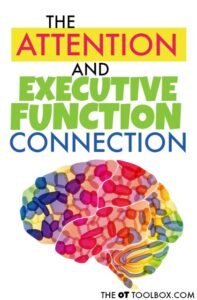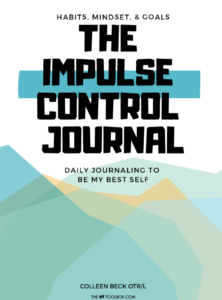Do you feel like you are constantly nagging your child to pay attention? Or do you find yourself saying “Sweetie, let’s focus!” every afternoon over homework? Are the students in your classroom distracted, lacking concentration, or tuned out? Using attention activities to help kids pay attention may be just the thing to help with kids who have a lot on their mind in the classroom or at home as critical thinking skills develop. These are activities to improve attention and concentration and can be a big help at home or at school.
Distractions can come in many forms. The child who is overly sensitive to sensory input may over respond to the slightest sounds, textures, sights, scents, tastes, or motions. Children who are excessively distracted by their sensory needs will struggle to attend to simple commands. Other children are able to “keep it together” in a classroom or home setting yet their concentration is challenged. Inattention can present as indifference, disregard, forgetfulness, carelessness, disinterest, neglect, or thoughtlessness. Kids might make mistakes or seem like they simply can’t pay attention. When a child is struggling to complete tasks, there can be many reasons or many signs of attention issues.
This resource is part of our new Executive Functioning Skills series. You will find information, executive functioning skill areas, strategies, and tools added to the drop down menu above.
Recognizing a connection between sensory processing and attention can be a key focus point. Our free attention and sensory workbook can help.

Improve Focus and Concentration
Limitations in cognitive abilities can impact all aspects of occupations in school, home, the community. Learning and daily activities provide opportunities for cognitive development, including attention, memory, problem solving. Additionally, concepts that children need for math and reading require attention and focus, including the ability to concentrate and attend to reading, counting and patterns in play are necessary for math concepts and early literacy skills.
In fact, there are a few key early literacy skills that are important building blocks:
- Alphabet Knowledge: Knowing letter forms along with their names and sounds
- Phonological Awareness: Discriminating and manipulating the sounds associated with spoken language
- Rapid Automatic Naming: Rapidly naming sequences of letters, numbers, colors, or objects
- Writing: Writing letters on request & name writing
- Phonological Memory: Remembering orally presented information for a short length of time
Occupational therapists have the skills to work with the educational team to address specific needs in the classroom related to literacy skill development. They can do this through multi-sensory approaches, while addressing any accommodations, and in meaningful and motivating means, all while supporting specific goals. A quick search found evidence-based interventions that can be used to promote pre-literacy skills in early childhood.
Some of these strategies include: facilitating the development of motor skills, sensory processing, postural control, and social interactions, as well as facilitating the development of alphabetic principle (specific letters correspond to specific letter sounds), phonological awareness (ability to discriminate and manipulate the sound structure), and phonemic awareness (understanding of a sound, like the initial sound of a word) into interventions. This can be included by incorporating multi-sensory approaches to formation of alphabet letters, use of finger plays, songs, and pre-writing tasks during interventions to promote the development of literacy skills (Frolek Clark, et al., 2011).
Inattentive Behaviors in kids
Understanding that attention and executive functioning skills are connected can be a helpful starting point in addressing the areas that play into a child’s inattentiveness. In fact what adds to a child’s inattentive behavior can be a variety of needs, from sensory processing components to executive functioning issues.
Addressing areas such as impulse control, problem solving, distractibility, self-regulation, and delayed gratification can be tools to address habits and mindset behind inattentive types of behaviors.
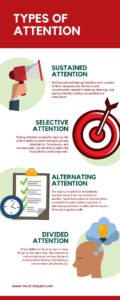
Types of Attention
There are various types of attention that kids can struggle with, each impacting function and independence in occupations of daily life for children in different ways. Mastering these types of attention are necessary for learning, safety, social skills, and function.
Under each description of the different types of attention, you’ll find activities to improve attention and concentration for that specific area.
Amazon affiliate links are included in this post.
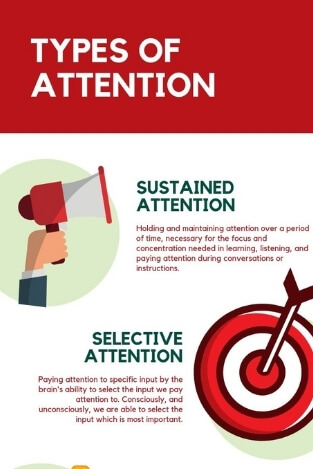
Sustained Attention
Holding attention over a period of time is necessary for the focus and concentration needed in learning, listening during lectures, paying attention during conversations or instructions. Reading a book requires the ability to pay attention over a period of time without becoming distracted. As reading requirements become more advanced in the older grades, sustained attention is challenged by chapter books and reading comprehension.
Activities to Improve Sustained Attention-
ord search- cross out all letter a’s, etc.
- Write out a list of words that start with a certain letter. Identify a certain number of words.
- Ordering information into alphabetical or numerical order
- Set a timer and complete a task or reading passage for a certain number of minutes
Selective Attention
By nature, we are able to select the input we pay attention to. Consciously, and unconsciously, we are able to select the input which is most important. This is visible by the student who listens to their teacher during a lesson while a lawn mower is running outside the classroom window. Anyone familiar with a classroom can imagine all of the stimuli which is thrown at a child at any given time: a fly on the window, the first snowflakes of the season falling outside, a flickering fluorescent light, a fellow classmate with a bad cough, a janitor cart passing by in the hallway, a student’s pencil that drops, a tapping of a shoe, a rumbling belly waiting for lunch…there is a lot going on which challenges selective attention! Having the ability to select from the many points of visual, auditory, interoceptive, tactile, stimuli in order to focus and attend to just one, is the brain’s ability to select and respond to just one factors that matter most.
Activities to Improve Selective Attention-
- Use visual cues
- Work on auditory skills
- Limit visual distractions
- Reduce background noise
- Position kids away from windows or hallways in the classroom
- The Focus Game
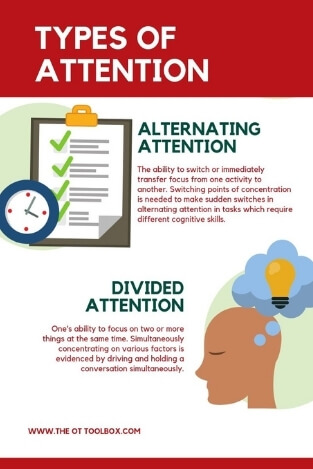
Alternating Attention
This type of attention refers to the ability to switch or immediately transfer focus from one activity to another. Switching points of concentration is needed to make sudden switches in alternating attention in tasks which require different cognitive skills. One example of this is cooking a meal and performing various tasks at once (boiling water, chopping carrots, and helping kids with homework is just one example. As a side note, it seems like teachers and parents excel in alternating attention. Alternating attention requires the ability to use the other attention types in tasks.
Activities to Improve Alternating Attention-
- Cooking with kids activities
- Musical chairs
- Eye Found It Game
- Flip cards in a deck and perform actions based on the suit, color, or number
- Sort coins or colored items
- Practice performing a task that can easily become distractible such as going online to send an email…or shopping in Target.
- The Sneaky, Snacky, Squirrel game
Divided Attention
Divided attention refers to one’s ability to focus on two or more things at the same time. Simultaneously concentrating on various factors is evidenced by driving and holding a conversation simultaneously. This ability to multi-task isn’t always an easy thing to manage. The ability to hold attention to various simultaneous point of concentration can require practice. A teen who is learning to drive will need the radio turned off and the only conversation in the car being verbal instructions from a parent or driving instructor. Only through practice does that new driver learn to concentrate on the road while the radio is playing.
Activities to improve divided attention-
- Practice games such as Connect Four with background distractions or verbal instructions
- Increasingly complex verbal memory games
- Simon with music playing in background
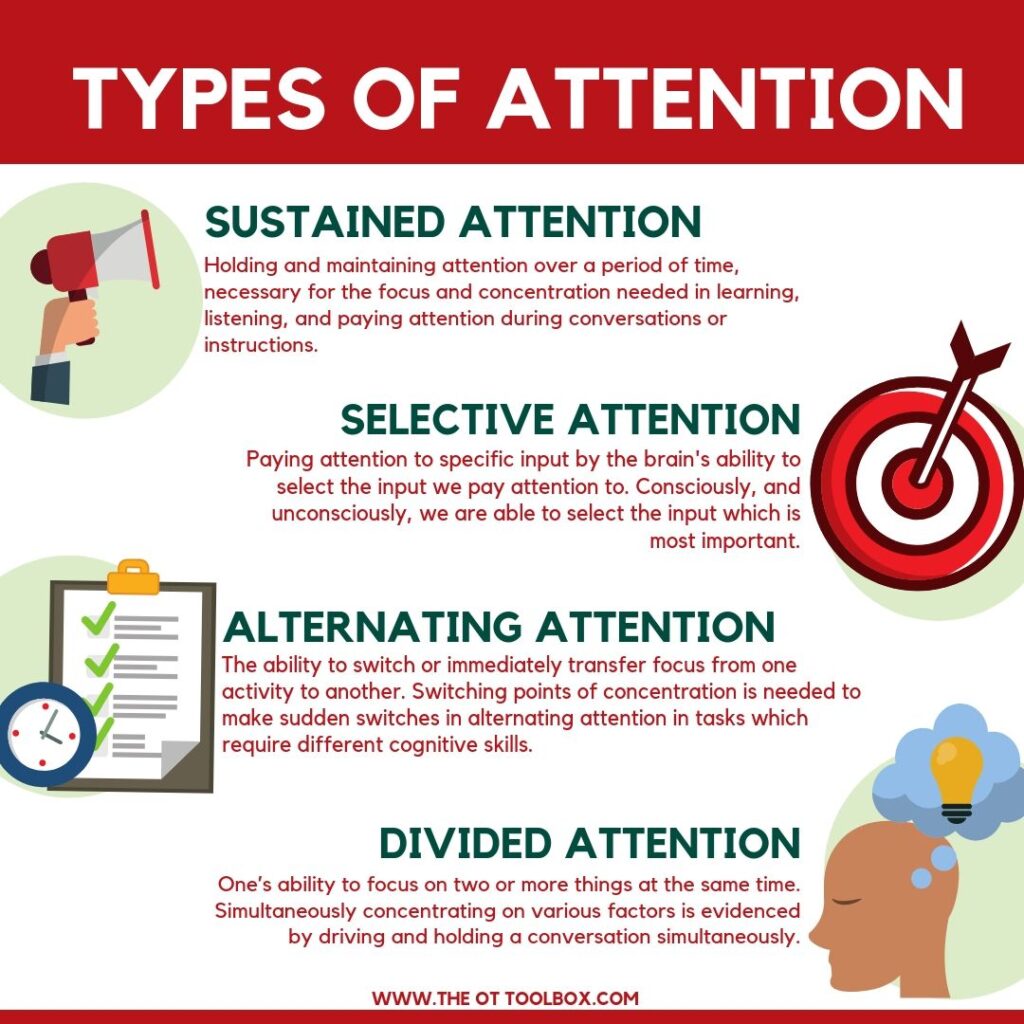
Attention Activities
Use the activities and strategies below to build attention skills or accommodate for struggles with attention so that children can become safe and active learners in all environments.
For classroom strategies, try adding a few attention-boosting classroom breaks, depending on the needs of the students you serve.
Attention Activities for kids
- Attention, Behavior, and Mealtimes
- Toys and Tools to Build Attention
- Organization and Attention Related to Sensory Processing
- Sensory Movement Activities for Attention
When it comes to boosting attention in kids, there is a lot going on. Attention is aligned with executive functioning, sensory processing, self-reflection, and so much more! Below, we are chatting about a few attention activities for kids. These are the ones that develop attention through games, activities, and fun. Being that a child’s primary occupation is play, why not develop the skills they need (like attention!) through active participation in an interest-based activity?
Some of these quiet fidget tools for the classroom may help.
Attention Deficits
Addressing attention can be addressed through focus exercises and tools to improve self-reflection in children. Understanding how a sit Helping children with self-reflection can be a valuable tool. Understanding a situation and reflecting on what worked and what didn’t work, along with strategic use of coping strategies is one way to address attention deficits in kids. These are the areas where a child struggles in the classroom, home, homework, extracurricular activities, or the community. Each child will be different and each child’s situation will differ. It makes sense that each child’s tools and strategies will differ, too.
- Attention During Meals
- Toys and Tools to Improve Visual Attention
- Attention and Behavior Issues in the Community
- Potty Training with Attention or Behavior Problems
- What is Executive Functioning in Child Development?
- Teach Kids with Attention Issues to Safely Cross the Street
- Improve Attention with Auditory Processing Strategies
- Adults with Executive Function Disorder
- Free Executive Function Email Course
More strategies to improve attention
The Impulse Control Journal is your ticket to helping kids manage their impulses, strategize ways to “shift gears”, and learn valuable lessons in self-regulation. This printable journal is a hands-on approach to improve attention and concentration.
The Impulse Control Journal is a self-regulation tool that will help:
- Children who have boundary issues
- Kids learning about self-control or who struggle with carryover of skills learned during one-on-one therapy sessions
- Kids with impulse control challenges that lead to safety concerns or learning issues
This printable journal has tools to address attention at all levels:
- Drawing Journal Pages to reflect and pinpoint individual strategies
- Journal Lists so kids can write quick checklists regarding strengths, qualities, supports, areas of need, and insights
- Journaling worksheets to pinpoint coping skills, feelings, emotions, and strategies that work for the individual
- Daily and Weekly tracking sheets for keeping track of tasks and goals
- Mindset, Vision, and Habit pages for helping kids make an impact
- Self-evaluation sheets to self-reflect and identify when inhibition is hard and what choices look like
- Daily tracker pages so your child can keep track of their day
- Task lists to monitor chores and daily tasks so it gets done everyday
- Journal pages to help improve new habits
- Charts and guides for monitoring impulse control so your child can improve their self-confidence
- Strategy journal pages to help kids use self-reflection and self-regulation so they can succeed at home and in the classroom
- Goal sheets for setting goals and working to meet those goals while improving persistence
- Tools for improving mindset to help kids create a set of coping strategies that work for their needs
Get your copy of the Impulse Control Journal to address attention and other underlying areas.
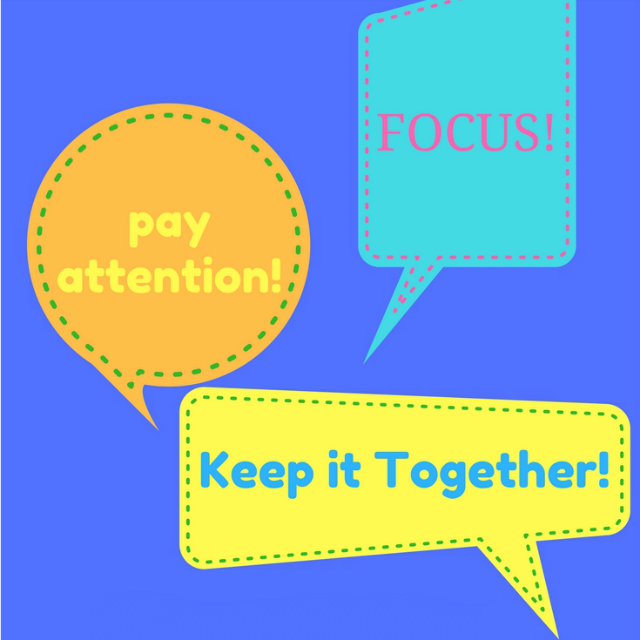
“Thinking and Doing” Attention
As we’ve covered above, there is a complex nature to attention as we use this executive functioning skill in every day activities. That is further broken down into the areas of thinking and doing.
Thinking Attention- This refers to sustained attention previous to a task and the process of mental skills to imagine a task. Thinking attention also refers to the cognitive skills of working memory, task completion, time management, flexible thinking, attention and other cognitive skills that require sustained thoughts.
Doing Attention- This refers to sustained attention during a task as it is carried out. Doing attention refers to what we see, or the behaviors at hand. In the classroom, this looks like the fidgety kid or the student that jumps up from their seat. These behaviors are connected to emotional response, inhibition, response flexibility during a task, and other actions.
Related to both “thinking and doing” components of attention is mental flexibility.
Mental Flexibility in mental tasks is sometimes referred to as cognitive shift or mental shift. This cognitive flexibility is your brain’s ability to adapt to new, changing, or unplanned events. Cognitive flexibility is also the ability to switch from one way of thinking to another. This is also known as task switching.
We can see really see challenges in distraction and multitasking when attentional flexibility is tricky.
occupational therapy activities to improve attention
As occupational therapy professionals, we can support the individual in a variety of settings. Depending on which environment results in functional skill deficits, that is the environment to consider. It might be that in the school, attention lacks as a result of a distracting classroom full of visual noise. Or perhaps auditory sensitivities impact attention. Despite these visual or auditory distractions, it is not necessarily a “sensory issue”, but an impulse control, sustained attention, working memory, etc. issue. These are areas that an OT can support through suggestions, tips, and consultation.
Likewise, attention at home can impact transition from school to home. The environment can play a role in organizing and completing homework and chore completion. There can be considerations that impact functional performance of self-care, social interactions, or participation in family events.
You can see how attention struggles can be vastly different depending on the individual!
Some ways OT can support individuals with attention challenges that impact functional performance:
- Teach how to do one task at a time before moving on
- Educate on the use of simplified instructions
- Instruct on how to use visual schedules
- Reduce distraction in the environment
- Trial attention apps and technology
- Instruct on time management
- Educate on time and supply preparation needed for a task
- Instruct how to use graphic organizers
- Show how to use visual or auditory prompts
- Slowly fade prompts and reinforcement
- Self-regulation teaching
- Educate on identifying goals and setting goals
- Education on metacognition, or critical thinking skills
- Brain breaks
- Social stories
- Mnemonics (memory tricks)
- Mindfulness strategies
- Body awareness training
- Yoga
- Sensory lifestyle/ sensory diet
Concentrating then on one task at a time before moving on is important. We need to make sure that everyone has received the instruction, one thing at a time. This is where visuals on the student’s desk can come into play. If the task is opening their language arts book to page 101, then maybe those instructions should be taped to the desk so the student knows exactly what is expected. And, if they are distracted, the teacher can walk by and point. This also does not bring attention to the student. The student could then check it off when they are finished. We need to make sure they are successful before moving on.
We need to keep these instructions simple and short. Again, we need to limit distractions. This includes homework and desk areas where they are working. We do not want clutter. We want to build a successful environment for them. You can also talk with parents or teachers about this.
Reference:
Frolek Clark, G. G., Schlabach, T. L., Barnett, M. E., Carr, M. A., Hinkle, B. L., Kluever, J. L., … Kluever, A. L. (2011, August). American Occupational Therapy Association, Inc. Retrieved from www.aota.org

Colleen Beck, OTR/L has been an occupational therapist since 2000, working in school-based, hand therapy, outpatient peds, EI, and SNF. Colleen created The OT Toolbox to inspire therapists, teachers, and parents with easy and fun tools to help children thrive. Read her story about going from an OT making $3/hour (after paying for kids’ childcare) to a full-time OT resource creator for millions of readers. Want to collaborate? Send an email to contact@theottoolbox.com.


